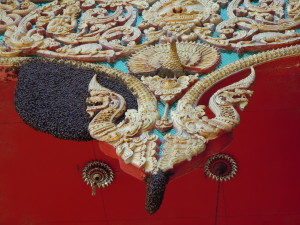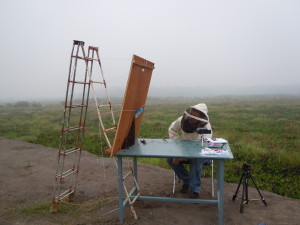Wednesday 9 July 2014
Dr James Makinson evicts bees from their homes for a good reason—to figure out how they collectively decide on the next place to live. His research on bee communication and consensus-building has been published in this month’s issue of Animal Behaviour.
James and his colleagues at the University of Sydney in partnership with two universities in Thailand have found that not all honeybee species think like the common Western hive bee when it comes to deciding on a place to nest.
Two little-known species—the giant Asian honeybee and the tiny red dwarf honeybee—use a more rapid collective decision-making process that enables them to choose a new home quickly. But they aren’t as fussy when it comes to the quality of their new home.
It’s work that could help with understanding and managing honeybees for pollination services, ecological health, and pest control.
“We know a fair bit about the nesting behaviour of honeybees through the work already done on the Western hive bee—the common honeybee that produces honey for our morning toast,” says James, a Postdoctoral Researcher at the University of Sydney, School of Biological Sciences.
“When Western hive bees want to find a new place to nest, the queen along with a subset of the colony’s workers set out as a swarm, which forms a temporary cluster in the vegetation close to their existing nest site. Then, from this cluster, scout bees take off and search for a specific nest location.”
According to James, the scout bees will spend around 40 minutes evaluating a potential nest site before returning to the swarm and communicating the distance, direction and the quality of the site they’ve found, through the figure-of-eight movements of their distinctive ‘waggle’ dance.
The scout bees then head back and re-evaluate the site a number of times before eventually convincing the entire swarm to move to a very specific location.
But James and his colleagues have found that the giant Asian honeybee and the red dwarf honeybee aren’t quite as fussy when it comes to deciding where to go.
“Both the giant Asian honeybee and red dwarf honeybee species come to a much more rapid decision,” says James. “We found that only during the final 15 minutes of the decision-making process do swarms reach a directional consensus on where to go, and that in some cases the scout bees’ dances were still indicating different distances. We assume they figure out a specific nest location once the swarm is on the move in that direction.”
From their observations, the team has developed computer models to help make sense of honeybee communication, which James says could also help inform new technologies in other areas.
“Hopefully in the near future, bee-inspired algorithms will be helping humanity solve complex problems and deal with big datasets.”
James was an Australian national finalist of FameLab—a global science communication competition for early-career scientists. He was also the winner of the NSW state final.
Media contacts:
Laura Boland, Science in Public/FameLab Australia, 0408 166 426, (03) 9398 1416, laura@scienceinpublic.com.au
Niall Byrne, Science in Public/FameLab Australia, 0417 131 977, (03) 9398 1416, niall@scienceinpublic.com.au
Verity Leatherdale, University of Sydney Media and Public Relations, 0403 067 342, (02) 9114 0748, verity.leatherdale@sydney.edu.au
James Makinson, University of Sydney, james.makinson@sydney.edu.au
Background
Consensus building in giant Asian honeybee, Apis dorsata, swarms on the move
James C. Makinson, Timothy M. Schaerf, Atsalek Rattanawannee, Benjamin P. Oldroyd, and Madeleine Beekman (2014), Animal Behaviour, Volume 93, July 2014, Pages 191–199
Abstract
Many animals move in groups, but the mechanisms by which a group of animals form a consensus about where to move are not well understood. In honeybees group movement generally falls into two behavioural categories: reproductive swarming and colony migration.
In both contexts the bees use the dance language to decide on a location to move to. During reproductive swarming bees choose between and dance for multiple discrete locations before departing towards one of them.
In contrast, during migration bees select a single direction in which to fly, but information with respect to distance is highly variable. In this study we show that swarms of the giant Asian honeybee, Apis dorsata, when placed in a novel environment rapidly reach a general consensus on a single patch within the environment in a fashion similar to relocating swarms of the red dwarf honeybee, Apis florea.
In the three swarms used in this study the patches for which bees danced prior to the swarm departing corresponded to a stand of trees.
One of our swarms showed a dance pattern consistent with long-distance migration: dances during the final 15 min preceding swarm departure indicated a wide range of distances but a uniform direction. Unlike previous descriptions of migrating swarm behaviour, the direction indicated by dances on this swarm changed throughout the decision-making process.
Our other two swarms landed within the canopy of the trees in the patches for which they danced in the last 15 min and then presumably searched the surrounding area for a specific location in which to construct their new comb.
http://www.sciencedirect.com/science/article/pii/S0003347214002000
Contact laura@scienceinpublic.com.au for a copy of the paper.
Acknowledgements
James’ work has been supported by the Australia – Asia Endeavour Award programme and the Australian Research Council (ARC).
His work has been undertaken in partnership with Chulalongkorn University, and Naresuan University, Thailand.
FameLab
In 2014, the British Council and Fresh Science have joined forces to bring FameLab to Australia.
FameLab Australia will offer specialist science media training and, ultimately, the chance for early-career researchers to pitch their research at the FameLab International Grand Final in the UK at The Times Cheltenham Science Festival from 3 to 5 June 2014.
FameLab is an international communication competition for scientists, including engineers and mathematicians. Designed to inspire and motivate young researchers to actively engage with the public and with potential stakeholders, FameLab is all about finding the best new voices of science and engineering across the world.
Founded in 2005 by The Times Cheltenham Science Festival, FameLab, working in partnership with the British Council, has already seen more than 5,000 young scientists and engineers participate in over 23 different countries — from Hong Kong to South Africa, USA to Egypt.
Now, FameLab comes to Australia in a landmark collaboration with the British Council and Fresh Science — Australia’s very own science communication competition.
For more information about FameLab Australia, head to www.famelab.org.au
Photos

A colony of the giant Asian honey bee (Apis dorsata) engulfing a naga-head motif on the awning of a temple in Chiang Rai province, northern Thailand. Credit: James Makinson.

James Makinson filming a giant Asian honey bee (Apis dorsata) cluster in Chiang Rai province, northern Thailand. Data from this swarm was published in Makinson et al 2014.

James Makinson presenting his talk at the FameLab Australia National Final in May. Credit: OK-White Lane © International FameLab

James Makinson presenting his talk at the FameLab Australia National Final in May. Credit: OK-White Lane © International FameLab
Videos
Download James’ videos of dancing bees here.
Captions for videos:
‘2011 Makinson et al A florea dance’: A red dwarf honey bee (Apis florea) scout performs a waggle dance in the bottom right-hand corner of the swarm’s horizontal dance floor. All 2,700 bees on the swarm cluster are individually marked using a four-colour combination of paint marks.
‘2011 Makinson et al A florea dancing and piping’: An individually marked red dwarf honey bee (Apis florea) swarm prepares to take to the air. Excited scout bees run across the swarm surface and perform their final waggle dances while producing an auditory piping signal to activate their swarm-mates.
‘2011 Makinson et al A florea swarm liftoff’: An individually marked red dwarf honey bee (Apis florea) swarm takes to the air after having reached a decision on where to go.
‘2011 Makinson et al Apis florea colony‘: One of five artificially created swarms (2 individually marked) monitored as part of Makinson et al 2011. All 2700 bees were individually marked using a four colour combination of paint marks.
‘2014 Makinson et al A dorsata marking dancer’: Giant Asian honey bee (Apis dorsata) scouts perform waggle dances for potential nesting locations on the vertical surface of a swarm cluster. Unmarked scouts are being marked by two of the authors of Makinson et al 2014.
‘2014 Makinson et al A dorsata swarm liftoff‘: A giant Asian honey bee (Apis dorsata) swarm takes to the air after having reached consensus on a direction to travel.







 Fresh Science is on hold for 2022. We will be back in 2023.
Fresh Science is on hold for 2022. We will be back in 2023.